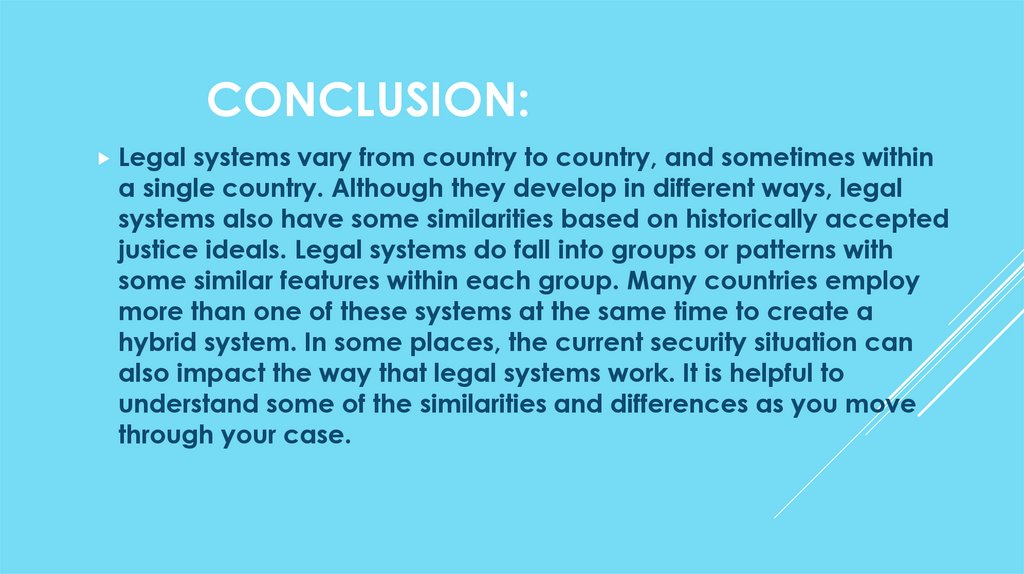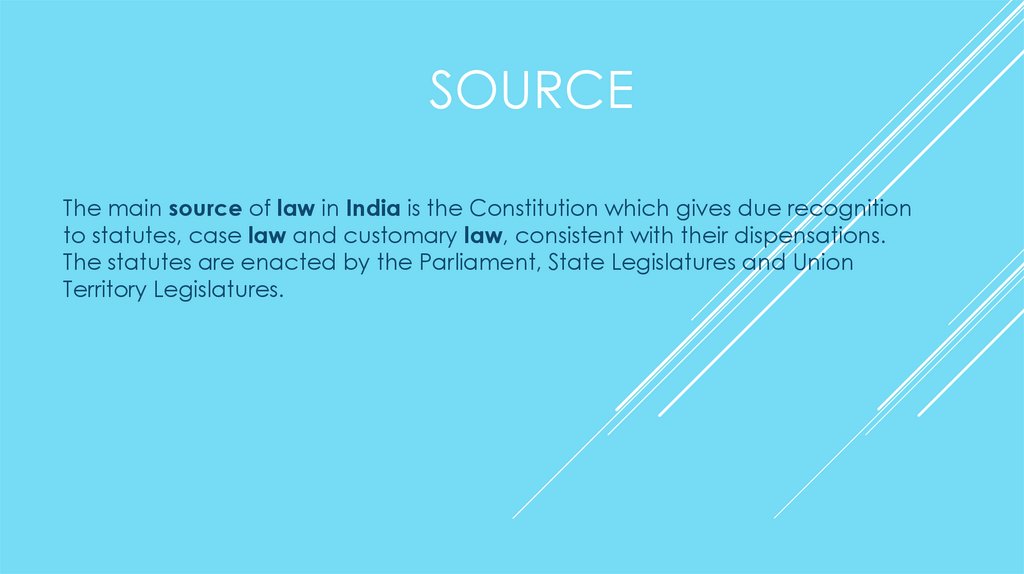Similar presentations:
Hussien Hussien
1.
NAME: HUSSIEN HUSSIENGROUP: 19ЛС4А
TOPIC: LEGAL SYSTEMS OF THE
WORLD
2.
INTRODUCTIONThe
contemporary national legal systems are
generally based on one of four basic systems:
civil law, common law, islamic law, indian law or
combinations of these. However, the legal
system of each country is shaped by its unique
history and so incorporates individual variations.
The science that studies law at the level of legal
systems is called comparative law.
3.
COMMON LAWCommon
law in England: the body of customary law,
based upon judicial decisions and embodied in
reports of decided cases, that has been administered
by the common-law courts of England since the
Middle Ages. From it has evolved the type of legal
system now found also in the United States and in
most of the member states of the Commonwealth
(formerly the British Commonwealth of Nations). In
this sense common law stands in contrast to the legal
system derived from civil law, now widespread in
continental Europe and elsewhere.
4.
Originsof common law: Common law is an invention of
the English courts: the Kings Bench, the Court of Common Pleas and the
Exchequer so as to ensure, as remains the case today, that there were laws
that superceded the decisions of the lesser courts.
Judges
create the common law by delivering written judgments about the
cases before them. If, for example, Magistrates’ Courts across England and
Wales were able to make and follow their own precedent, this would create
a huge variation in local and regional customs that could mean that local
regimes are barely recognisable from one another.
5.
StatuteLaw in England By: Lorna Elliott LLB
(hons), Barrister - Updated: 5 Oct 2015
Statute
Law is law that is written down and
codified into law. Statutes begin as bills: and there
are public and private bills.
Public
Acts are those that affect either the whole
of the UK or some of its constituent
countries: England, Scotland, Wales and Northern
Ireland, whereas private Acts may grant limited
powers to public bodies such as local authorities,
or apply only to specific locations within the UK.
6.
Commonlaw in united states: the
American system is a “common law”
system, which relies heavily on court precedent
in formal adjudications. In our common law
system, even when a statute is at issue, judicial
determinations in earlier court cases are
extremely critical to the court’s resolution of the
matter before it the American system is a
“common law” system, which relies heavily on
court precedent in formal adjudications. In our
common law system, even when a statute is at
issue, judicial determinations in earlier court
cases are extremely critical to the court’s
resolution of the matter before it.
7.
The United States and most Commonwealth countries are heirs to the commonlaw legal tradition of English law. Certain practices traditionally allowed under
English common law were expressly outlawed by the Constitution, such as bills
of attainder and general search warrants.As common law courts, U.S. courts
have inherited the principle of stare decisis. American judges, like common
law judges elsewhere, not only apply the law, they also make the law, to the
extent that their decisions in the cases before them become precedent for
decisions in future cases.
8.
Theactual substance of English law was formally
"received" into the United States in several ways.
First, all U.S. states except Louisiana have
enacted "reception statutes" which generally
state that the common law of England
(particularly judge-made law) is the law of the
state to the extent that it is not repugnant to
domestic law or indigenous conditions. Some
reception statutes impose a specific cutoff date
for reception, such as the date of a colony's
founding, while others are deliberately vague.
9.
CIVIL LAWCivil
law, also called Romano-Germanic law, the law of continental
Europe, based on an admixture of Roman, Germanic, ecclesiastical,
feudal, commercial, and customary law. European civil law has been
adopted in much of Latin America as well as in parts of Asia and Africa
and is to be distinguished from the common law of the Anglo-American
countries.
The
term civil law has other meanings not employed in this article. The
term jus civile, meaning “civil law,” for example, was used in ancient
Rome to distinguish the law found exclusively in the city of Rome from
the jus gentium, the law of all nations, found throughout the empire. The
phrase has also been used to distinguish private law, governing the
relations between individuals, from public law and criminal law. Finally,
in the philosophy of law, civil law sometimes refers to the positive law of
the state, as distinct from natural law.
10.
The Law of France refers to the legal system in the FrenchRepublic, which is a civil law legal system primarily based
on legal codes and statutes, with case law also playing an
important role. ... The Constitution of France adopted in
1958 is the supreme law in France.
11.
InFrance the Revolutionary period was one of
extensive legislative activity, and long-desired
changes were enthusiastically introduced. A new
conception of law appeared in France: statute was
deemed the basic source of law. Customs remained
only if they could not be replaced by statutes.
The Parlements, the major courts of the nation, were
dismantled and replaced by a unified system of
courts that were merely supposed to apply the law
and never to lay down general rules.
12.
The lawof Germany (German: das Recht
Deutschlands), that being the modern German legal
system (German: Deutsches Rechtssystem), is a system
of civil law which is founded on the principles laid out
by the Basic Law for the Federal Republic of Germany,
though many of the most important laws, for example
most regulations ...
13.
Romanlaw, as embodied in the Corpus Juris Civilis, was “received” in
Germany from the 15th century onward, and with this reception came a
legal profession and a system of law developed by professionals
(Juristenrecht). Roman law provided the theoretical basis for legal
progress that culminated in the work of the scholars of the 19th century.
Under this tradition, the legal process has been viewed in Germany as the
application of more or less generally formulated rules to individual cases.
14.
Germancourts traditionally have not been as
dominant in developing the law as have their
counterparts in the common-law countries.
Roman law provided tools to strengthen
sovereignty, as well as the correlative ideas that
the legislative function is a state monopoly and
that the responsibility for the development of law
rests with a legally trained state-controlled
bureaucracy
15.
CONCLUSION:Legal
systems vary from country to country, and sometimes within
a single country. Although they develop in different ways, legal
systems also have some similarities based on historically accepted
justice ideals. Legal systems do fall into groups or patterns with
some similar features within each group. Many countries employ
more than one of these systems at the same time to create a
hybrid system. In some places, the current security situation can
also impact the way that legal systems work. It is helpful to
understand some of the similarities and differences as you move
through your case.
16.
ISLAMIC LAWHISTORY: Islamic law grew along with the expanding Muslim Empire. The
Umayyad dynasty caliphs, who took control of the empire in 661,
extended Islam into India, Northwest Africa, and Spain. The Umayyads
appointed Islamic judges, kadis, to decide cases involving Muslims.
(Non-Muslims kept their own legal system.)
Characteristic:
1-Divine revelation
4- Flexibility (not rigid)
2-Completeness
5-Just/ Fair
3-Universality
17.
STRUCTUREis a religious law forming part of the Islamic tradition.[1][2] It is derived from the religious
precepts of Islam, particularly the Quran and the hadith. In Arabic, the
term sharīʿah refers to God's immutable divine law and is contrasted with fiqh, which
refers to its human scholarly interpretations.[3][4][5] The manner of its application in
modern times has been a subject of dispute between Muslim
fundamentalists and modernists.[6][1]
Traditional theory of Islamic jurisprudence recognizes four sources of Sharia: the
Quran, sunnah (authentic hadith), qiyas (analogical reasoning),[note 1] and ijma (juridical
consensus).[8] Different legal schools—of which the most prominent
are Hanafi, Maliki, Shafiʽi school, Hanbali and Jafari—developed methodologies for
deriving Sharia rulings from scriptural sources using a process known
as ijtihad.[3][4] Traditional jurisprudence (fiqh) distinguishes two principal branches of
law, ʿibādāt (rituals) and muʿāmalāt (social relations), which together comprise a wide
range of topics.[3][5] Its rulings are concerned with ethical standards as much as with
legal norms,[9][10] assigning actions to one of five
categories: mandatory, recommended, neutral, abhorred, and prohibited.[3][4][5] Thus,
some areas of Sharia overlap with the Western notion of law while others correspond
more broadly to living life in accordance with God's will.
18.
SOURCEThe Qur'an is the principal source of Islamic law, the Sharia. It contains the rules by which
the Muslim world is governed (or should govern itself) and forms the basis for relations between
man and God, between individuals, whether Muslim or non-Muslim, as well as between man and
things which are part of creation.J
The primary sources of Islamic law are the Holy Book (The Quran), The Sunnah (the traditions or
known practices of the Prophet Muhammad ), Ijma' (Consensus), and Qiyas (Analogy).
19.
INDIAN LAWHISTORY: Law in India primarily evolved from customary practices and
religious prescription to the modern well codified acts and laws based on a
constitution. Though the recorded history of law starts only in the Vedic
period, it is widely believed[by whom?] that ancient India had some sort of
legal system in place even during the Bronze Age and the Indus Valley
civilization.[1] The various stages of evolution of Indian law is classified as
that during the Vedic period, the Islamic period, the British period and post
independence.
20.
CHARACTERISTICS8 Important Features of Indian Constitution
World's Longest Constitution. ...
Taken from various sources. ...
Federal System with Unitary Features. ...
Parliamentary Form of Government. ...
Balance between the Sovereignty of Parliament and Judicial Supremacy.
...
Independent and Integrated Judicial System. ...
Directive Principles of State Policy.
21.
STRUCTUREThe Indian Constitution has adopted a bicameral legislature at the union level. The
Indian Parliament comprises two Houses, the:
Lok Sabha (House of the People). The political party or coalition of political parties with
a majority in the Lok Sabha forms the government. The members of the Lok Sabha are
directly elected by the people from their territorial constituencies.
Rajya Sabha (Council of States). The members of the Rajya Sabha are indirectly
elected from the state assemblies.
However, the legislative powers of these two Houses are quite similar.
At the state level, there is the state legislature. All states have a legislative assembly
(which is similar to the Lok Sabha) and some states may also have a second House
(that is, a legislative council). Currently, only seven of the 28 states have a legislative
council. The legislative assemblies have significantly more power than the legislative
councils. The number of the state legislature members depends on the population of
the specific state.
22.
SOURCEThe main source of law in India is the Constitution which gives due recognition
to statutes, case law and customary law, consistent with their dispensations.
The statutes are enacted by the Parliament, State Legislatures and Union
Territory Legislatures.






















 law
law








